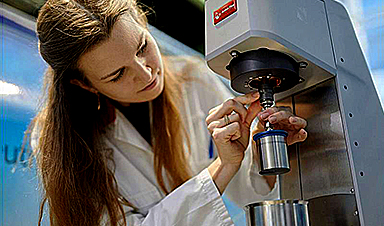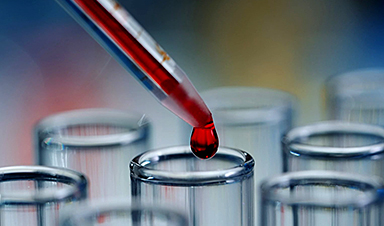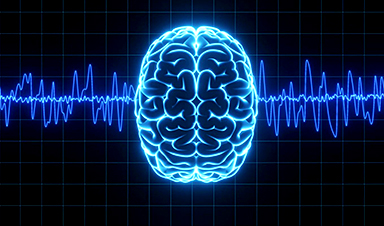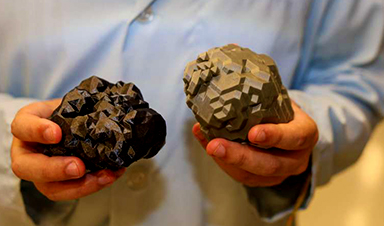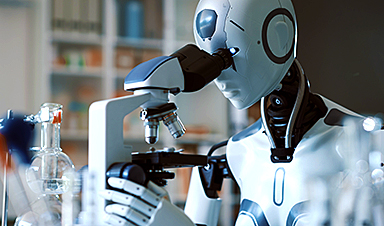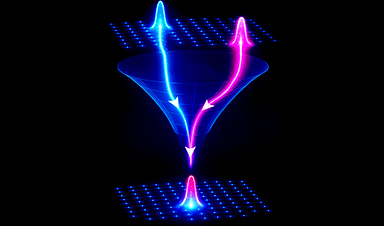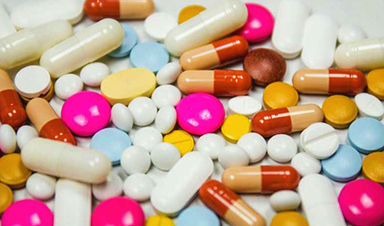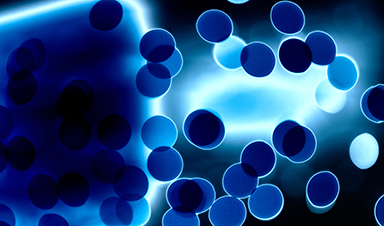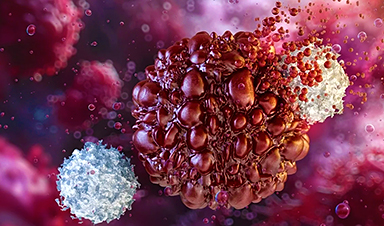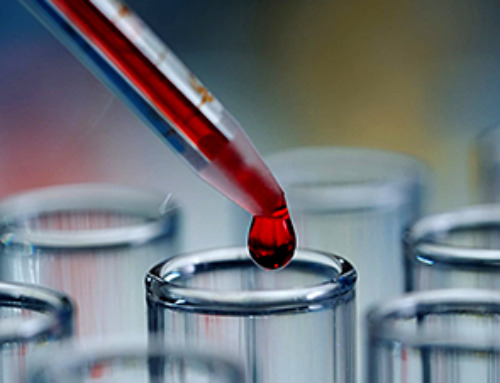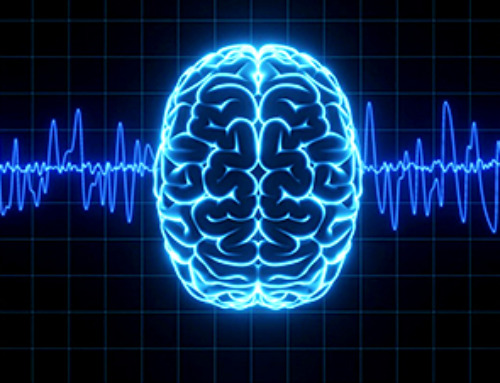Up to 3% of people with diabetes have an allergic reaction to insulin. A team at Forschungszentrum Jülich has now studied a method that could be used to deliver the active substance into the body in a masked form—in the form of tiny nanoparticles.
The insulin is only released in the target organ when the pH value deviates from the slightly alkaline environment in the blood. The molecular transport system could also serve as a platform for releasing other drugs in the body precisely at the target site.
It’s an old dream in pharmacy: To deliver an active ingredient to the exact place in the body where it is most needed—a cancer drug, for example, directly to the tumor tissue. This minimizes its side effects on other organs and ensures that it has its maximum effect at its target.
The concept is called targeted drug delivery. The actual active ingredient is packaged in a transport substance and thus introduced into the body. Once it reaches its destination, a certain stimulus (e.g. the oxygen content or pH value) ensures that the encapsulated cargo is released again.
A team at Forschungszentrum Jülich has just presented the concept for such a drug cab, which could benefit people with diabetes in particular.
“Some of those affected are allergic to insulin—the drug that they have to use every day to adjust their blood sugar levels,” explains Anastasiia Murmiliuk, a researcher at the Jülich Center for Neutron Science (JCNS) who played a key role in the development and characterization of the molecular transport system, reported in the Journal of Colloid and Interface Science.
An allergy to insulin is rare. But for people with type 1 diabetes in particular, there is no alternative to administering the messenger substance. Each time the insulin preparation is injected, the skin around the injection site reddens. The area swells, itches and hurts. It can even result in an anaphylactic reaction with shortness of breath and circulatory problems.
“Our idea was to mask the insulin for the immune system. To do this, we selected a synthetic polymer that binds the insulin to itself,” says the chemist.
The complexes of insulin and polymer molecules combine to form nanoparticles and can then be transported in the blood vessels to the organs. In the slightly alkaline environment of the blood, the two components initially remain firmly bound together. In the tissue, however, the pH value changes—and insulin and polymer separate from each other.
“Polymers, i.e., long-chain molecules, are fascinating compounds. Their properties can be tailored to specific applications,” says Murmiliuk. The polymer that the researcher selected for insulin transport is biodegradable and consists of two units: a water-loving part that ensures solubility and stability in the blood, and a charged part that binds the insulin.
The polymer for insulin transport consists of two units: Longer chain segments made of polyethylene glycol ensure that the complexes are well compatible with water (and therefore also with blood). Connected to them are shorter chain segments that carry positive charges. These are crucial for the polymer to attach to insulin, which itself is negatively charged under the pH value of the blood.
The electrostatic interaction between the positive and negative charges ensures that tiny particles just 40 nanometers in size are formed from the two components. The pH value at which the two components separate again can be controlled to a certain extent by chemically modifying the polymer.
Using various scattering methods, the team from Jülich was able to determine not only the size of the particles, but also their internal structure: The water-loving sections of the polymer form the outer shell of the particles, while the charged chain parts nestle against the insulin on the inside.
“We were able to show that three insulin molecules are closely packed together,” explains Murmiliuk. In many conventional preparations, insulin is present in dissolved form in a six-pack, which then has to gradually break down into the active individual molecules. The three-pack in the nanocarriers could therefore act more quickly.
The small-angle neutron scattering method has proven to be particularly useful for studying the polymer insulin particles, says Aurel Radulescu, neutron scattering expert at JCNS.
“Unlike X-rays, neutrons can ‘see’ the hydrogen in a sample and distinguish between hydrogen and deuterium (heavy hydrogen). If we replace the hydrogen in all but one component of the nanoparticles with deuterium, we can specifically visualize only this one component, i.e. only the polymer or only the insulin,” says Radulescu.
“In this way, we can selectively create the contrast between the two components and the solvent and see in detail how our drug-taxi is constructed.
“It was particularly important to analyze a broad size range from a few angstroms to micrometers with the same neutron instrument to ensure a thorough structural analysis of the polymer-protein complexes and their larger assemblies. There are very few small-angle neutron diffractometers in the world that offer this capability, and we included some in our study.”
So far, the team has only been able to show in the laboratory that the molecular transporter works. Studies in blood and tissue samples are still pending.
Nevertheless, the researchers believe that complexes of a synthetic polymer and a natural protein such as insulin can be developed into a pharmaceutical platform. And this would allow not only insulin, but also a variety of active substances to be efficiently introduced into the body. “We tried this out with a dye that occurs in a similar form in blood or in leaf green and is used to diagnose and treat cancer. It was trapped in the nanoparticles and was released after the pH value had changed significantly as the particles fell apart,” they say.
In the future, this could also be used to encapsulate active ingredients that are poorly soluble in water. Radulescu and Murmiliuk are thinking primarily of anticancer drugs. Since tumors have a different pH value than other cells, this approach can be used to deliver anticancer drugs directly to cancer cells without harming “healthy” cells.
More information: Anastasiia Murmiliuk et al, Polyelectrolyte-protein synergism: pH-responsive polyelectrolyte/insulin complexes as versatile carriers for targeted protein and drug delivery, Journal of Colloid and Interface Science (2024). DOI: 10.1016/j.jcis.2024.03.156
Provided by Forschungszentrum Juelich
News
Advancements and clinical translation of intelligent nanodrugs for breast cancer treatment
A comprehensive review in "Biofunct. Mater." meticulously details the most recent advancements and clinical translation of intelligent nanodrugs for breast cancer treatment. This paper presents an exhaustive overview of subtype-specific nanostrategies, the clinical benefits [...]
It’s Not “All in Your Head”: Scientists Develop Revolutionary Blood Test for Chronic Fatigue Syndrome
A 96% accurate blood test for ME/CFS could transform diagnosis and pave the way for future long COVID detection. Researchers from the University of East Anglia and Oxford Biodynamics have created a highly accurate [...]
How Far Can the Body Go? Scientists Find the Ultimate Limit of Human Endurance
Even the most elite endurance athletes can’t outrun biology. A new study finds that humans hit a metabolic ceiling at about 2.5 times their resting energy burn. When ultra-runners take on races that last [...]
World’s Rivers “Overdosing” on Human Antibiotics, Study Finds
Researchers estimate that approximately 8,500 tons of antibiotics enter river systems each year after passing through the human body and wastewater treatment processes. Rivers spanning millions of kilometers across the globe are contaminated with [...]
Yale Scientists Solve a Century-Old Brain Wave Mystery
Yale scientists traced gamma brain waves to thalamus-cortex interactions. The discovery could reveal how brain rhythms shape perception and disease. For more than a century, scientists have observed rhythmic waves of synchronized neuronal activity [...]
Can introducing peanuts early prevent allergies? Real-world data confirms it helps
New evidence from a large U.S. primary care network shows that early peanut introduction, endorsed in 2015 and 2017 guidelines, was followed by a marked decline in clinician-diagnosed peanut and overall food allergies among [...]
Nanoparticle blueprints reveal path to smarter medicines
Lipid nanoparticles (LNPs) are the delivery vehicles of modern medicine, carrying cancer drugs, gene therapies and vaccines into cells. Until recently, many scientists assumed that all LNPs followed more or less the same blueprint, [...]
How nanomedicine and AI are teaming up to tackle neurodegenerative diseases
When I first realized the scale of the challenge posed by neurodegenerative diseases, such as Alzheimer's, Parkinson's disease and amyotrophic lateral sclerosis (ALS), I felt simultaneously humbled and motivated. These disorders are not caused [...]
Self-Organizing Light Could Transform Computing and Communications
USC engineers have demonstrated a new kind of optical device that lets light organize its own route using the principles of thermodynamics. Instead of relying on switches or digital control, the light finds its own [...]
Groundbreaking New Way of Measuring Blood Pressure Could Save Thousands of Lives
A new method that improves the accuracy of interpreting blood pressure measurements taken at the ankle could be vital for individuals who are unable to have their blood pressure measured on the arm. A newly developed [...]
Scientist tackles key roadblock for AI in drug discovery
The drug development pipeline is a costly and lengthy process. Identifying high-quality "hit" compounds—those with high potency, selectivity, and favorable metabolic properties—at the earliest stages is important for reducing cost and accelerating the path [...]
Nanoplastics with environmental coatings can sneak past the skin’s defenses
Plastic is ubiquitous in the modern world, and it's notorious for taking a long time to completely break down in the environment - if it ever does. But even without breaking down completely, plastic [...]
Chernobyl scientists discover black fungus feeding on deadly radiation
It looks pretty sinister, but it might actually be incredibly helpful When reactor number four in Chernobyl exploded, it triggered the worst nuclear disaster in history, one which the surrounding area still has not [...]
Long COVID Is Taking A Silent Toll On Mental Health, Here’s What Experts Say
Months after recovering from COVID-19, many people continue to feel unwell. They speak of exhaustion that doesn’t fade, difficulty breathing, or an unsettling mental haze. What’s becoming increasingly clear is that recovery from the [...]
Study Delivers Cancer Drugs Directly to the Tumor Nucleus
A new peptide-based nanotube treatment sneaks chemo into drug-resistant cancer cells, providing a unique workaround to one of oncology’s toughest hurdles. CiQUS researchers have developed a novel molecular strategy that allows a chemotherapy drug to [...]
Scientists Begin $14.2 Million Project To Decode the Body’s “Hidden Sixth Sense”
An NIH-supported initiative seeks to unravel how the nervous system tracks and regulates the body’s internal organs. How does your brain recognize when it’s time to take a breath, when your blood pressure has [...]
